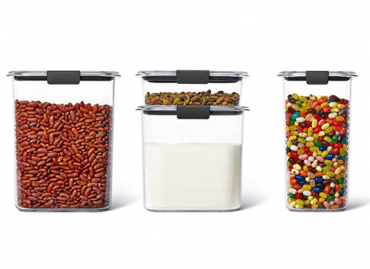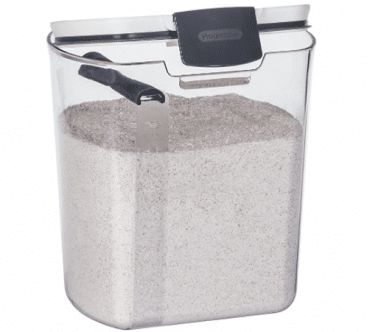Having sufficient survival skills and proper survival gear is of paramount importance for survival or homestead in 2023. Your situational awareness is of great help, too. When you know what to put in your survival backpack, your level of preparedness is great. But when it comes to cooking, some preppers and homesteaders fail to show good awareness. However, real prepping should involve this knowledge, as well.
Food storage is an issue for all those people who are really concerned about consuming fresh and well-preserved produce. If you prefer to keep large amounts of products, you will need to be accurate about the shelf life of each of them. It’s always very disappointing when some kind of food goes bad after quite a short time, right? The good news is that following some advice can extend the time of your food being of good quality.
Flour has been one of the most important products for humanity since ancient times — can you imagine living without bread, pasta, bakery, etc.? Any serious crisis, no matter what type of crisis it is, can lead to the lack of flour on the market, which might become a terrible problem for most of us. Having no flour (or other basic products) will mean that you are unable to make your own food in case ready-made options get too expensive.
The flour on your pantry shelf is considered to stay good for usage during a long period of time, though you should prevent it from spoiling if we talk about several months and more.
In this article, we will look into all possible ways to prolong the flour’s shelf life.
Different Types of Flour Shelf Life
There are numerous types of flour available in the stores, such as:
- Whole grain flour (such as spelt, rye, and brown rice flours);
- Alternative flour (coconut flour, oat flour, or nut flours);
- Various refined flours (such as all-purpose flour (or white flour), bread flour, and self-rising flour).
Depending on what type of flour we are looking at, its shelf life will differ. Whole grain flours are considered best in terms of taste and beneficial microelements. Whole grain flours are a perfect source of protein, fiber, and various vitamins.
Whole grain flour contains quite a lot of oils, which means that you can store it in an airtight container for up to six months. To make sure that your whole grain flour doesn’t go bad, better keep it in the freezer.
Alternative flours are considered healthy because they are grain- and gluten-free. Most of them, depending on the original product, has a special interesting taste.
Alternative flour should always be kept at a lower temperature because of a very high concentration of oils in it. Make sure not to miss the moment of its deterioration — you will know by the smell.
Refined flour is probably not the healthiest one, though it is the most convenient and cheapest to use.
Refined flours have a long shelf life — they are stored for up to two years and don’t require to be put in the freezer. Mind that self-rising flour may lose its self-arising qualities because the baking soda contained in this product will lose its potency after some time.
Using Other Alternatives
You don’t necessarily need to have fresh flour at home if you are satisfied with its alternatives, such as wheat berries or rolled oats.
You can obviously cook them the way you wish or grind flours out of these products. Experts believe that wheat berries ground into whole wheat flour can be stored for up to six months or more, especially if you store flour the ways described below (e.g., in an airtight container or in mylar bags with oxygen absorbers).
Rolled oats’ shelf life is longer — you can use it safely within at least 12 months (using proper storage containers or mylar bags with oxygen absorbers will also extend this period).
Grinding your own wheat is a good idea because of the following reasons:
- You can plant wheat berries and eventually get more of them, which makes the product renewable;
- Wheat berries are considered healthier than refined flour;
- Dropping wheat berries doesn’t make it bad for usage, whereas dropping white flour on the floor means you’ll have to throw it into the rubbish.
There are some downsides as well:
- This type of flour will go bad quicker because of the oils contained in it;
- You have to purchase special equipment to grind your flour;
- It is not always easy to find this product in the store.
Why Flour Goes Bad
The most common reasons why this product can go bad are these:
- Moisture;
- Oxygen;
- Insects;
- Light.
If the flour is left in contact with anything wet, the probability that it gets moldy is genuine. Be careful not to miss the moment — you’ll be able to smell the mold before there are the first visible signs.
Oxidation is the next consequence that might take place if the flour is stored the wrong way. This is the process of natural oils, contained in the flour (and especially in whole grain flours), going rancid.
When you buy the flour, you obviously don’t expect any insects to be there. However, unfortunately, sometimes insects’ eggs are already in the package, and if they are, moths or other insects like these will appear.
What is more, flour can absorb the smells of the near-standing objects. As a result, the cupcakes you’ve baked may remind you of a fish that was left nearby the flour. Important! Never keep your flour or any other food products close to chemicals of any kind.
What You Shouldn’t Do
Some people believe that dry canning helps to sterilize the dry substance such as flour and create a seal, making the product’s shelf life very long.
NM State University specialists warn the readers that dry canning is not only ineffective but might also be dangerous. Here is why:
- There’s no scientific proof that dry canning does sterilize food;
- Heating the container might result in moisture appearing inside;
- Be careful: the heated jar can explode!
So How to Store Flour the Right Way?
As we know, normally your flour must be used within one or two months. However, if you choose the right container and follow some useful advice, this period may become three months and even more. The product of outstanding quality is considered to be stored for up to 10 years if you store flour properly.
1. Choose an Airtight Container


2. Freeze the Flour
This way to store the product will prolong the shelf life of your flour up to forever. Keep the sealed flour in the freezer until the moment you need it. Once there is a necessity, take it out, let it get the room temperature, and use it. Make sure that there is no moisture in the flour — a stolen container will help to prevent undesirable condensation, while a paper bag will most likely get your flour spoiled.
Fortunately, there is a way to save the flour even if it got damp. Spread it on the sheet of baking paper and heat it in the oven (it might take an hour or so). To finish the procedure, don’t forget to sift the product to remove any clumps.
3. Vacuum Sealing
Vacuum seal your flour if you are interested in long-term food storage. Vacuum sealed flour will remain usable for up to two years. This way to store food will definitely prevent any flour bugs from getting into the food saver; however, if there are any eggs, they will still begin to hatch after some time. What is more, sealed mylar bags (or other containers like that) are not considered completely leak-proof, so there is a possibility of air and moisture seeping through, though it’s much less likely compared to storing your flour in mason jars and similar packaging.
How to Vacuum Seal Flour the Right Way?
- Place the entire bag of flour into a sealer bag (don’t remove its original container);
- Vacuum seal the flour until the air is completely removed;
- Put the sealed plastic bag into the freezer for at least 4 days (it will help to kill the insect eggs, which may probably be there in the original packaging);
- Make sure to let the plastic bag get the room temperature before putting the flour into other containers if you don’t consider freezer storage convenient.
4. Various Containers With Oxygen Absorbers
Oxygen absorbers are special bags with iron that trap oxygen and save your flour from getting rancid. Lack of oxygen means that no weevil eggs can hatch there in the container, as well as oxygenation is prevented. Putting oxygen absorbers into a proper container may get you to store the flour for years.
The best idea is to use a food-grade bucket or a canning jar as a long-term flour storage container. They are considered more reliable in comparison with simple plastic buckets and other non-airtight containers prone to air leakage.
5. Mylar Bags With Oxygen Absorbers
This is the best way of long-term storage if we talk about any dry product. A mylar bag is made of a special material that prevents light, moisture, and oxygen from getting into the container. Placing there an additional oxygen absorber will make it almost impossible for the insect eggs (if there are any) to hatch. Your flour will be good and ready to use for many years: the approximate shelf life of the flour stored this way is ten years and more.
Frequently Asked Questions (FAQ)
Do methods of storing flour depend on its type?
The best ways of flour storage are usable for each type of flour, no matter what exactly it is: whole wheat flour, refined flour, or ground wheat berries that you turned into flour yourself. Better not store flour in a paper bag — opt for transferring it into a more reliable storage container (storing flour often leads to finding flour bugs in the packaging).
What are the best long-term storage tricks?
The best way to store wheat flour is by putting it into mylar bags with oxygen absorbers, which will almost completely isolate the flour from moisture and oxygen. A mylar bag is made of metalized polyester, which means they are tougher than simple ziplock bags. Other options you may find appropriate are: using food-grade buckets, sealing brown paper bags, or putting the flour in the freezer.
Is oven canning effective?
There is no evidence that dry canning really helps to sterilize a product. However, there is proof that condensation may appear inside the can after you put it out to room temperature, meaning that the flour can absorb moisture. It is also dangerous to heat up the flour in the can because this container might explode.
When is the flour considered rancid?
Storing flour long-term requires transferring it from the original bag. If you don’t store flour in an air-tight container (such as mylar bags that have as much air out as possible), your flour can go bad quite soon, especially if this is not white flour but whole grain flour or some type of an alternative (wheat berries, almond flour, etc.). Rancid flour can be identified by the smell or hatching of insect eggs.
Can I avoid flour bugs?
Storing flour in large amounts can turn into a disaster if there appear to be insect eggs. Wrong food storage will eventually get them hatched, making the whole bucket of your flour (whole wheat, white flour — no matter what) rancid. A way to store your flour longer with no worries about the bugs is adding food-grade diatomaceous earth inside the container — it is supposed to kill the insects.


